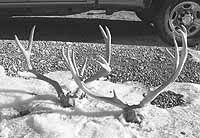| Shed antlers and horns may be legally gathered and possessed. Antler hunters are subject to specific regulations, especially if the antlers are attached to a skull plate. |
With spring just around the corner, shed antler and horn gathering can be an exciting treasure hunt for enthusiasts of all ages. Along with the fun of searching for antlers, there are certain regulations that must be heeded, regarding the possession of antlers and horns.
According to Wildlife Rules, a person may possess antlers or horns from lawfully harvested animals as well as ‘shed’ antlers and horns. (Refer to the 2005 Utah Big Game Proclamation, page 16.) A shed antler or horn is one that has dropped from a big game animal (moose, elk, deer and pronghorn) as part of its life cycle. Antler sheds have a rounded base, commonly called a button or burr. Sheds from a pronghorn antelope are a hollow sheath. No other horned animal sheds.
Shed antlers and horns may be possessed at any time. There are no restrictions on their barter, trade or sale. In contrast, antlers or horns that are attached to the skull plate must have been legally harvested or purchased. The owner (of the antlers/horns attached to the skull) must keep a transaction record, which includes the name and address of the hunter, his permit number and the date of purchase/sale.
Antlers, heads and horns of legally harvested animals may only be purchased or sold between February 15 and July 31 annually. The transaction record allows the DWR to identify legally-harvested animals; thereby discouraging the unlawful harvest of big game, simply for the trophy value of their antlers and horns.
A deer sheds its antlers during February and March. Elk shed later than deer and at higher elevations. This year, heavy snows blanket the high country. Much of the mid-elevation sagebrush steppe zone is dead or dying from many years of drought. This has forced elk and deer to concentrate at lower elevations. Winter range crowding increases an animal’s stress, due to competition for food and space. Low energy reserves are taxed even more by human activity.
Careless shed antler and horn hunters can tip the delicate energy balance, contributing to big game winterkill. Probably the worst threat comes from irresponsible OHV use. Off-road travel is illegal and should not be practiced when gathering antlers. Reports have come in about OHVs, chasing deer and elk through trees to knock off their antlers. This practice is both extremely damaging and illegal. Anyone, caught harassing wildlife, will be prosecuted to the fullest extent of the law. Whether on foot or riding an OHV, please pay attention to the animal’s body language. If it appears nervous or begins to move away, give the animal more space by backing off or traveling in another direction.
Shed gathering can be a great family outing. Please avoid picking up antlers attached to the skull plate,when gathering sheds. Instead, mark the area and contact the local conservation officer.
Please respect the space and needs of wintering big game to minimize adverse effects.

